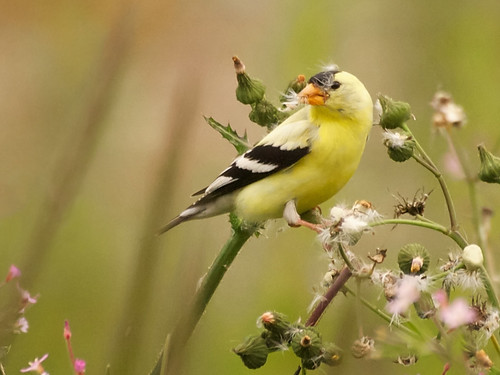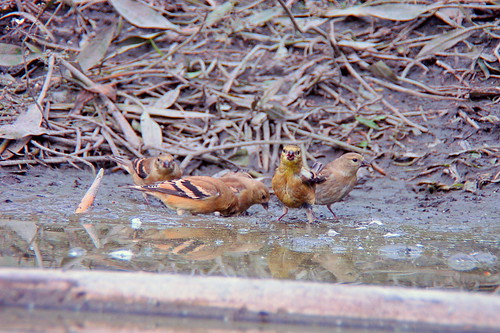As summer turns to fall, many of our avian neighbors on Capitol Hill are losing their breeding plumage and settling into their winter look. If you watch carefully over the next few weeks, you might catch a male American goldfinch — our Washington state bird — in a scruffy, half-molted state.
During summer, male American goldfinches have bright yellow body feathers and a black cap. Now, and for the next six weeks or so, these birds are dropping their old feathers and growing a complete set of new ones. By the middle of November, they’ll have a sedate olive-colored body and crisp-looking black-and-white wings. Their bill color will also change from bright yellow to black.
American goldfinches will keep this drab look until early spring, when the males will regain their bright yellow body plumage. But the spring molt is only partial; goldfinches hang onto a single set of black-and-white wing feathers for the full year.
Nearly all birds undergo a complete molt sometime in late summer or early fall. It can be hard to catch them at it, especially if the changes in their plumage aren’t as striking as those of the goldfinch. But if you look closely, you may see some changes. For example, European starlings look little more speckled in their brand-new plumage at this time of year.
If you’d like to see an American goldfinch in its scruffy, half-molted state, Volunteer Park is a good place to look.
Interested in Learning More?
- Check out the page for the American goldfinch at the Cornell Lab of Ornithology.
- Listen to the song of the American goldfinch at the Macaulay Library of Natural Sounds.
- David Allen Sibley, author of the popular Sibley Guide to the Birds, posted a great animation of the yearly plumage changes of the male American goldfinch on his blog.
Previous Aviary Posts
- The Bard, the birds and the battle for Hill gardens
- Annoying Hill crows are actually smart little bird brains
- Swallows pursue unlicensed construction project beneath 520 bridge
- Hill welcomes avian arrivals from the tropics
- More…
Melissa Koosmann is a freelance writer and resident of Capitol Hill. She writes about education, culture, gardening and nature — and, sometimes, birds for CHS.





Thank you for the ongoing series. I didn’t realized that starlings molted and have noticed the difference in feathers before, but thought it was a species variation. As a budding bird watcher, I love the details of changing beak color and identifiable characteristics. We recently saw a goldfinch in our garden, I’ll keep an eye out for him/her.
Thanks. Since you’ve noticed the change in starlings already, keep paying attention. Many starlings’ bills change color around this time of year, too.
Our very natitve thistle are prime for the goldfinch. They land and dig out the seeds under the down. Very pretty birds. Had a house with a side yard full of big thistle, I left them just for the birds, many, many showed in the fall. Quite a display.
Washington state bird by the way.
We had always wondered whether our goldfinches really lost their bright feathers or whether some other chemical change in their bodies was responsible for the change in their coloration. Now we know! But we still think that losing all those feathers is very “expensive” in surviving our more hostile MN weather conditions.
Sure, it’s expensive. But feathers wear out, so birds have to grow a new set every year. Virtually all birds do a molt before winter, presumably because they’re mostly done feeding chicks and have a short window of time when the food is still relatively plentiful. And those drab feathers make it easer to avoid being eaten during the exposed winter months, when the deciduous trees are bare of leaves.
Growing those pretty yellow feathers in spring is expensive, too–and it’s an expense the goldfinches pay for dearly. It takes their bodies so long to molt into their breeding plumage that they only have a short window of time left over for the actual breeding. Many other birds have a long enough breeding window that if one nest fails, they can lay a new set of eggs. For goldfinches, a single nest failure frequently means that the reproductive opportunity has passed for the year.